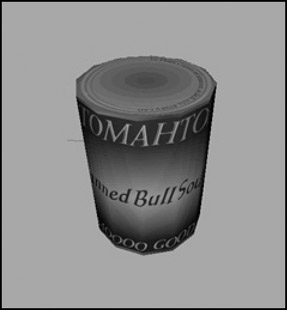The Skin Creation Process
When we begin the skinning process, we will have a bare, unadorned 3D model of some kind. For this little demonstration, we'll use a simple soup can (see Figure 9.1). It's a 12-sided cylinder with a closed top and bottom (end caps). Each side face is made up of two triangles, and the end caps are made of 12 triangles each, for a total of 48 triangles. Nothing too special here.

Figure 9.1: The victim—a simple can of soup.
Using the UV Unwrapping tool, we have to basically spread all our faces out over a nominally flat surface (see Figure 9.2).

Figure 9.2: Laying it all out—the unwrapped can.
We save the image of the UV template, plus we save the original model file, because the UV Unwrapping tool will have modified the UV coordinates for the objects in the model, and we can save those changes to the file so that the modeling tool can read them back in again.
Then we import the unwrapped image with the lines indicating the face edges into an image processing tool like Paint Shop Pro and apply whatever textures, colors, or symbols we need, such as shown in Figure 9.3.

Figure 9.3: After applying textures.
Notice that for textures I simply created markings and re-created a simple label. For the top of the can I made some circular text, and for both end caps I made a circular pattern that represents the ridges you often find in those places on tin cans. The image file has now officially become a skin for the can!
The final step is to import the new skin into the modeling program (or the game) and view the results, as in Figure 9.4.

Figure 9.4: Aha! Not such a simple can anymore. Nutritious, too!
The part of the process we will focus on in this chapter is the activity shown in Figure 9.3, the actual creation of the textures on the UV template, so that it can be later used as a skin for models.
EAN: 2147483647
Pages: 197